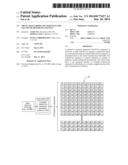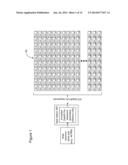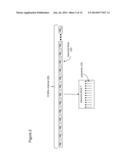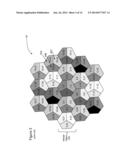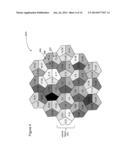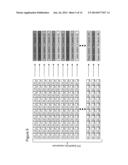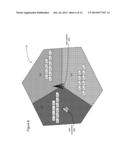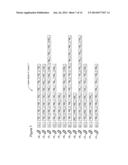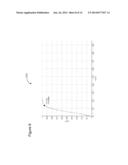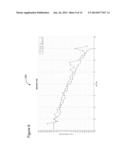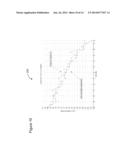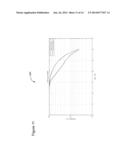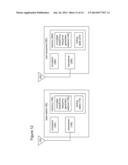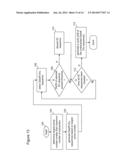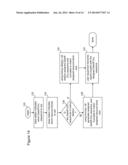Patent application title: TRUNCATED ZADOFF-CHU SEQUENCE FOR LTE UPLINK REFERENCE SIGNALS
Inventors:
Candy Yiu (Beaverton, OR, US)
Candy Yiu (Beaverton, OR, US)
Shahrnaz Azizi (Cupertino, CA, US)
Shahrnaz Azizi (Cupertino, CA, US)
Assignees:
INTEL CORPORATION
IPC8 Class: AH04J1300FI
USPC Class:
370208
Class name: Multiplex communications generalized orthogonal or special mathematical techniques particular set of orthogonal functions
Publication date: 2014-06-26
Patent application number: 20140177427
Abstract:
A method to generate truncated Zadoff-Chu sequences is disclosed. A large
Zadoff-Chu sequence is generated, based on a maximum transmission
bandwidth, then the sequence is truncated based on the actual
transmission bandwidth. The Zadoff-Chu sequence is cyclicly extended, as
needed, to maintain a quasi-orthogonal characteristic. The result is that
there is an increased number of available Zadoff-Chu sequences for
distribution in a wireless neighborhood and the rate of interference is
reduced.Claims:
1. A method, comprising: multiplying a maximum resource block size by a
number of subcarriers per resource block to obtain a value, wherein the
maximum resource block size is based on a bandwidth of a wireless
transmission channel; obtaining a largest prime number smaller than the
value, resulting in a second value; generating a Zadoff-Chu sequence
using a formula, wherein the sequence is based on the second value; and
truncating the Zadoff-Chu sequence, resulting in a truncated Zadoff-Chu
sequence, based on a second resource block size, wherein the second
resource block size is associated with a second bandwidth.
2. The method of claim 1, further comprising: coupling the truncated Zadoff-Chu sequence to a signal for transmission over the wireless transmission channel at the second bandwidth.
3. The method of claim 1, wherein the Zadoff-Chu sequence has a size equal to the largest prime number, the method further comprising: cyclicly extending the Zadoff-Chu sequence to a second size, wherein the second size equals the maximum resource block size multiplied by the number of carriers per resource block; wherein the Zadoff-Chu sequence is quasi-orthogonal.
4. The method of claim 1, further comprising: measuring a peak-to-average power ratio (PAPR) of the Zadoff-Chu sequence; and if the PAPR exceeds a predetermined value, discarding the Zadoff-Chu sequence.
5. The method of claim 4, further comprising: generating a cyclic shift of the Zadoff-Chu sequence, resulting in a cyclic-shifted Zadoff-Chu sequence; and truncating the cyclic-shifted Zadoff-Chu sequence, resulting in the truncated Zadoff-Chu sequence; wherein the truncated Zadoff-Chu sequence is coupled to the signal for transmission over the wireless transmission channel.
6. The method of claim 5, further comprising: storing the Zadoff-Chu sequence in a lookup table; and storing the cyclic-shifted Zadoff-Chu sequence in the lookup table.
7. The method of claim 1, wherein the bandwidth is 10 MHz and the maximum resource block size is 48.
8. The method of claim 7, wherein each resource block in the 10 MHz bandwidth has twelve data subcarriers.
9. The method of claim 1, generating the Zadoff-Chu sequence using the formula further comprising using the following formula: x ( n ) = - jπ un ( n + 1 ) N ZC , ##EQU00002## for 0.ltoreq.n≦NZC-1 and wherein NZC is the second value.
10. The method of claim 1, further comprising: generating additional Zadoff-Chu sequences using the second value; and cyclicly extending the Zadoff-Chu sequences so that the number of Zadoff-Chu sequences is equal to the value, resulting in a plurality of Zadoff-Chu sequences; wherein the plurality of Zadoff-Chu sequences are quasi-orthogonal.
11. A user equipment, comprising: an antenna to transmit signals to and receive signals from a remote entity in a wireless neighborhood; a transceiver coupled to the antenna; a memory to store a software program; and a processor to execute the software program, wherein the software program performs the following operations: receiving, from a base station, an assignment of a Zadoff-Chu sequence from a plurality of Zadoff-Chu sequences; receiving, from the base station, an assignment of one or more resource blocks from a plurality of resource blocks, wherein plurality of resource blocks characterize a bandwidth of a wireless transmission channel; obtaining the assigned Zadoff-Chu sequence; truncating the assigned Zadoff-Chu sequence based on the resource block assignment, resulting in a truncated Zadoff-Chu sequence.
12. The user equipment of claim 11, wherein the software program further performs the following operation: generating the assigned Zadoff-Chu sequence using the following formula: x ( n ) = - jπ un ( n + 1 ) N ZC , ##EQU00003## for 0.ltoreq.n≦NZC-1 and wherein NZC is obtained by multiplying a maximum resource block size by a number of subcarriers per resource block to obtain a value, wherein the maximum resource block size is based on the bandwidth of the wireless transmission channel.
13. The user equipment of claim 12, wherein the software program further performs the following operation: cyclicly shifting the first Zadoff-Chu sequence, resulting in the assigned Zadoff-Chu sequence.
14. The user equipment of claim 11, further comprising: a lookup table loaded into the memory, wherein the software program retrieves the assigned Zadoff-Chu sequence from the lookup table.
15. The user equipment of claim 11, wherein the software program further performs the following operation: transmitting the signal to be transmitted with the truncated Zadoff-Chu sequence.
16. The user equipment of claim 14, wherein the software program further performs the following operation: retrieving the assigned Zadoff-Chu sequence from the lookup table, wherein the assigned Zadoff-Chu sequence is a cyclic-shifted version of another Zadoff-Chu sequence.
17. An article comprising a medium storing instructions to enable a processor-based system to: generate a Zadoff-Chu sequence using a formula, wherein the formula accepts as input a predetermined value, wherein the predetermined value is based on a bandwidth of a wireless transmission channel; receive an indication of which resource blocks to use for transmitting a signal over the wireless transmission channel; and truncate the Zadoff-Chu sequence based on the indication, resulting in a truncated Zadoff-Chu sequence.
18. The article of claim 17, further storing instructions to enable the processor-based system to: couple the truncated Zadoff-Chu sequence to a signal for transmission over the wireless transmission channel at a second bandwidth.
19. The article of claim 17, further storing instructions to enable the processor-based system to: multiply a maximum resource block size by a number of subcarriers per resource block to obtain a value, wherein the maximum resource block size is based on a bandwidth of a wireless transmission channel; obtain a largest prime number smaller than the value, resulting in a second value; subtract one from the second value, resulting in the predetermined number.
20. The article of claim 17, further storing instructions to enable the processor-based system to: measure a peak-to-average power ratio of the Zadoff-Chu sequence; and discard the Zadoff-Chu sequence if the peak-to-average power ratio exceeds a predetermined value.
21. The article of claim 17, further storing instructions to enable the processor-based system to: generate a cyclic shift of the Zadoff-Chu sequence, resulting in a cyclic-shifted Zadoff-Chu sequence; truncate the cyclic-shifted Zadoff-Chu sequence based on the indication, resulting in a cyclic-shifted truncated Zadoff-Chu sequence; and couple a signal to be transmitted with the cyclic-shifted truncated Zadoff-Chu sequence.
Description:
CROSS-REFERENCE TO RELATED APPLICATIONS
[0001] This application claims priority to U.S. Provisional Patent Application No. 61/523,080, filed on Aug. 12, 2011.
TECHNICAL FIELD
[0002] This application relates to Zadoff-Chu sequences and, more particularly, to a method to increase the number of reference signals.
[0003] BACKGROUND
[0004] A Zadoff-Chu sequence is a mathematical sequence that is applied to radio signals to improve the properties of the radio signals as they are transmitted through the air in a wireless neighborhood. The Zadoff-Chu sequences are complex numbers, each one having a real portion and an imaginary portion. Orthogonality is one of the desired characteristics of radio signals coupled with Zadoff-Chu sequences. Such radio signals are considered less likely to cause interference in the wireless neighborhood.
[0005] Other characteristics also make radio signals coupled with Zadoff-Chu sequences desirable. Zadoff-Chu sequences have good auto-correlation properties and can be searched for in both the time and frequency domains. All Zadoff-Chu points have a constant amplitude of one.
[0006] Despite these characteristics, the number of available Zadoff-Chu sequences limits the number of entities that may use the sequences in the wireless neighborhood.
[0007] Thus, there is a continuing need for a method to use Zadoff-Chu sequences that overcomes the shortcomings of the prior art.
BRIEF DESCRIPTION OF THE DRAWINGS
[0008] The foregoing aspects and many of the attendant advantages of this document will become more readily appreciated as the same becomes better understood by reference to the following detailed description, when taken in conjunction with the accompanying drawings, wherein like reference numerals refer to like parts throughout the various views, unless otherwise specified.
[0009] FIG. 1 is a simplified block diagram of a truncated Zadoff-Chu sequence generation method, according to some embodiments;
[0010] FIG. 2 is a simplified block diagram of a 10 MHz channel divided into 48 resource blocks, with twelve sub-carriers per resource block, according to some embodiments;
[0011] FIG. 3 is a simplified diagram of a wireless neighborhood in which the base station reuses Zadoff-Chu sequences, according to the prior art;
[0012] FIG. 4 is a simplified diagram of a wireless neighborhood in which each sector uses a unique Zadoff-Chu sequence created by the method of FIG. 1, according to some embodiments;
[0013] FIG. 5 is a simplified block diagram showing one arrangement of the Zadoff-Chu sequences created by the method of FIG. 1, according to some embodiments;
[0014] FIG. 6 is a simplified diagram showing a possible arrangement of Zadoff-Chu sequences by one cellular region of the wireless neighborhood of FIG. 4, according to some embodiments;
[0015] FIG. 7 is a simplified diagram showing a resource block allocation of twelve mobile devices, where each device uses the same Zadoff-Chu sequence, according to some embodiments;
[0016] FIG. 8 is a graph illustrating a cumulative distribution function of the cross-correlation of all possible pairs of the newly truncated Zadoff-Chu sequences created by the method of FIG. 1, according to some embodiments;
[0017] FIG. 9 is a graph illustrating a mean square error performance comparison between the original Zadoff-Chu sequence and the newly truncated Zadoff-Chu sequences generated by the method of FIG. 1, according to some embodiments;
[0018] FIG. 10 is a graph illustrating the channel estimation error performance comparison between the original sequence and the newly truncated Zadoff-Chu sequence generated by the method of FIG. 1, with a variable bandwidth assignment over fifty-seven sectors, according to some embodiments;
[0019] FIG. 11 is a graph illustrating the peak-to-average power ratio complementary cumulative distribution function for both the original Zadoff-Chu sequence and the newly truncated Zadoff-Chu sequence generated by the method of FIG. 1, according to some embodiments;
[0020] FIG. 12 is a block diagram of a base station using the Zadoff-Chu sequence generation method of FIG. 1, according to some embodiments;
[0021] FIG. 13 is a flow diagram illustrating operations performed by the Zadoff-Chu sequence generation method of FIG. 1, according to some embodiments; and
[0022] FIG. 14 is a flow diagram illustrating operations performed between the base station and user equipment, according to some embodiments.
DETAILED DESCRIPTION
[0023] In accordance with the embodiments described herein, a method to generate truncated Zadoff-Chu sequences is disclosed. The method modifies the existing methodology for generating truncated Zadoff-Chu sequences, with the result being an increased number of available Zadoff-Chu sequences for distribution in a wireless neighborhood.
[0024] In the following detailed description, reference is made to the accompanying drawings, which show by way of illustration specific embodiments in which the subject matter described herein may be practiced. However, it is to be understood that other embodiments will become apparent to those of ordinary skill in the art upon reading this disclosure.
[0025] For simplicity, in describing the truncated Zadoff-Chu generation method herein, reference is made to the long-term evolution, or LTE, standard, (also known as the 3rd generation partnership project, or 3GPP), which is known to employ Zadoff-Chu sequences for several applications. However, it is to be understood that the truncated Zadoff-Chu generation method may be employed with other wireless standards. The following detailed description is, therefore, not to be construed in a limiting sense, as the scope of the subject matter is defined by the claims.
[0026] Further, the Zadoff-Chu sequences are described herein as being in conjunction with the transmission of reference signals to a base station by a wireless mobile device. However, the truncated Zadoff-Chu sequence generation method described herein may be used for other transmissions and should not, therefore, be construed as being limited to the reference signal application.
[0027] The Zadoff-Chu function is a type of spreading function used in LTE to optimize signal transmissions through a wireless neighborhood. The Zadoff-Chu sequences are generated using the following formula:
x ( n ) = - jπ un ( n + 1 ) N ZC , ##EQU00001##
for 0≦n≦NZC-1 and NZC=the length of the sequence. In some embodiments, the truncated Zadoff-Chu generation method 100 modifies the existing Zadoff-Chu sequences used in the LTE environment to increase the number of reference signals that are available to be used in the wireless neighborhood.
[0028] Reference signals are transmitted, in part, to estimate the transmission channel. So, suppose the channel is a 10 MHz channel and there are 48 resource blocks available for distribution to different users. Suppose also that the channel is populated by a single user and a single base station (known in LIE parlance as eNodeB). The LTE specification defines the following valid resource block sizes for sounding reference signals: 4, 8, 12, 16, 20, 24, 32, 36, 40 and 48. Thus, the single user may be allocated all 48 resource blocks, and could transmit in those allocations four resource blocks at a time, for a total of 12 transmissions, to the base station. This would be one way to cover the entire 10 MHz band. Or, the user may send a single transmission using all 48 resource blocks. Or, the user may send multiple transmissions using eight resource blocks at a time, twelve resource blocks at a time, and so on.
[0029] It is likely that the wireless neighborhood will have more than one user, so the base station will allocate the 48 resource blocks to the users based on other criteria. Practically, the base station may allocate four resource blocks, eight resource blocks, and so on to a given user. Further, the base station determines which of the 48 resource blocks to allocate to the user, based on reference signals periodically received from the user. The user may send the reference signals at different frequency sub-bands within the 10 MHz band, because, initially, neither the base station nor the user knows which frequency sub-band is optimal for transmission for that user.
[0030] The reference signal itself is a signal known to the base station. When the user periodically transmits the reference signal to the base station, the received signal includes not just the reference signal, but additional channel characteristics. From this received signal, the base station is thus able to do channel estimation.
[0031] The number of available Zadoff-Chu sequences equals one less than the prime number that is used in its generation. The prime number used in Zadoff-Chu sequence generation is the largest prime number less than or equal to the length of the sequence. In the current 3GPP LTE standard, the smallest resource block size is three resource blocks. Each resource block has twelve subcarriers, so the smallest resource block size would have 36 subcarriers. One less than the largest prime number less than or equal to the length of the sequence is thus 30. Thus, according to the traditional rule for generating Zadoff-Chu sequences, thirty sequences are available for a resource block sire of three.
[0032] FIG. 1 is a simplified block diagram of the truncated Zadoff-Chu sequence generation method 100, according to some embodiments. The truncated Zadoff-Chu sequence generation method 100, by contrast with the prior art, increases the number of available Zadoff-Chu sequences, by starting with a larger resource block sire. In some embodiments, the method 100 assumes that 48 resource blocks, or 576 subcarriers, are to be used for transmissions. The largest prime number less than or equal to 576 is 571. One less than 571 is 570. Therefore, according to the method 100, the total number of available Zadoff-Chu sequences increases front 30 to 570, denoted ZC1-ZC570. The truncated Zadoff-Chu sequence generation method 100 thus takes a resource block of size 48 and generates 570 Zadoff-Chu sequences 60.
[0033] Assume Xi(u) is the Zadoff-Chu sequence, with root sequence u and 1≦i≦576. In some embodiments, when a resource block of size smaller than 48 resource blocks is needed (which characterizes many if not most transmissions), a smaller set of Zadoff-Chu sequences is also needed. In this circumstance, the 48-resource block Zadoff-Chu sequence is truncated to the desired size.
[0034] For example, to generate a Zadoff-Chu sequence for a resource block of size three, the Zadoff-Chu sequence generation method 100 takes a Zadoff-Chu sequence, X(u), having 571 subcarriers, and truncates the Zadoff-Chu sequence to a sequence of size 36: Xj(u), . . . , Xj+36(u), where 1≦j≦535 (the upper limit on j ensures that the 36 selected subcarriers are within the 571 available subcarriers of the Zadoff-Chu sequence).
[0035] In some embodiments, to ensure that the truncated Zadoff-Chu sequence is good, the following properties are maintained:
[0036] good cross-correlation between all sequences and cyclic shifted sequences (FIG. 8)
[0037] improved channel estimation performance
[0038] low peak-to-average power ratio (PAPR)
[0039] FIG. 2 is a simplified block diagram schematically depicting a 10 MHz channel 26 divided into 48 resource blocks 22, according to some embodiments. In fact, there are fifty resource blocks assigned to a 10 MHz channel under LTE. However, two of the resource blocks are dedicated to control channels. Thus, for purposes of this discussion, the 10 MHz channel has 48 resource blocks dedicated to data subcarriers. Each resource block 22 has twelve subcarriers 24, indicated as upward facing arrows. Thus, the 10 MHz channel 26 is allocated 48×12, or 576 subcarriers.
[0040] The LTE specification supports several different channel bandwidths, with the wider bandwidths having greater channel capacity. LTE supports channel bandwidths of 1.4 MHz, 3 MHz, 5 MHz, 10 MHz, 15 MHz, and 20 MHz. The number of resource blocks varies with the channel bandwidth. In illustrating the truncated Zadoff-Chu sequence generation method 100, a 10 MHz bandwidth is used. However, the principles described herein may readily be applied to other channel bandwidths.
[0041] When the 570 Zadoff-Chu sequences 60 are generated by the method 100 (FIG. 1), each sequence has the 571 subcarriers of the 10 MHz channel available. The 571 subcarriers are then cyclically extended to 576 subcarriers. Because of this extension, the resulting sequences are said to be quasi-orthogonal rather than completely orthogonal. When distributing a Zadoff-Chu sequence 60 to a user (known as user equipment, or UE, in LTE parlance), the resource block size of the user will determine how many subcarriers are used to send the Zadoff-Chu sequence for that user.
[0042] FIG. 3 shows a wireless neighborhood 50 having 57 sectors, according to the prior art. Each hexagon represents a cellular region 30 consisting of a base station 90 (not shown) serving three sectors 40A, 40B, and 40C (collectively, sectors 40). The wireless neighborhood 50 is a cellular network consisting of nineteen cellular regions 30, each cellular region containing three sectors 40. Each sector 40) includes a two-part number. The first part indicates the base station 90 and the second part indicates the sector 40 being served by the base station.
[0043] Thus, for example, at the center of the wireless neighborhood 50 is a cellular region 30), with three sectors 40, denoted "1.0". "1.1", and "1.2", which means. "base station 1 services sectors 0, 1, and 2". A cellular region 30 to its left, denoted "2.3", "2.4", and "2.5", indicates, "base station 2 services sectors 3, 4, and 5". An adjacent cellular region 30, denoted "3.6", "3.7", and "3.8", indicates, "base station 3 services sectors 6, 7, and 8", and so on, until all 57 sectors 40 have been assigned to a base station. The nineteenth cellular region, denoted "19.54", "19.55", and "19.56" indicates, "base station 19 services sectors 54, 55, and 56".
[0044] With the limited number of Zadoff-Chu sequences available under the 3GPP/LTE standard, the cellular regions 30 of the prior art wireless neighborhood 50 are color-coded to denote how the Zadoff-Chu sequences may be practically allocated so as to avoid interference. Thus, the arrangement of FIG. 3, base stations 6, 8, and 11 each have a yellowish/whitish cellular region 30, and each is allocated the same three Zadoff-Chu sequences, one for each of its three sectors. Thus, base station 6 allocates the same Zadoff-Chu sequence for its sector 15 as does base station 8 for its sector 21, which is also the same Zadoff-Chu sequence allocated by base station 11 for its sector 30 (all three sectors featuring a light yellow color in FIG. 3). Base station 6 allocates a different Zadoff-Chu sequence for its sector 16 (darker yellow) than for its sector 15, but that same Zadoff-Chu sequence is going to be reused by the base station 8 for its sector 22 and by the base station 11 for its sector 31. Note that this is just an example of deployment in the prior art. Other examples may have different arrangements of Zadoff-Chu sequences, but nonetheless bear the same limitation of availability of only thirty Zadoff-Chu sequences per LTE specification when the index of the base sequence selection is set to zero.
[0045] Other base stations in the wireless neighborhood 50 similarly share the limited available Zadoff-Chu sequences, as indicated by the color-coding in FIG. 3. With the limited sequences available, reuse of the Zadoff-Chu sequences is needed to service all 57 sectors. The allocation is done so as to spread the shared Zadoff-Chu sequences as far apart as possible, so as to minimize the chance of interference. Nevertheless, interference may still occur.
[0046] Further, with the popularity of wireless technology, it is likely that each base station will need to service multiple users within each of its three allocated sectors 40. It is not difficult to imagine, for example, each base station servicing thirty users simultaneously, ten in each of its three sectors.
[0047] In some embodiments, the truncated Zadoff-Chu sequence generation method 100 solves the above problem by generating 570 Zadoff-Chu sequences 60, with each ZC sequence having all subcarriers of the wireless channel available for transmission. For transmissions that are smaller than all 48 resource blocks 22 (most transmissions), the ZC sequence 60 is truncated, as needed, and the base stations within the wireless neighborhood 50 do not have to reuse Zadoff-Chu sequences 60 that are assigned to nearby base stations.
[0048] FIG. 4 shows a wireless neighborhood 50A, according to some embodiments. Like the wireless neighborhood 50 of the prior art (FIG. 3), the wireless neighborhood 50A features nineteen cellular regions 30, each cellular region having three sectors 40, for a total of 57 sectors. In this enhanced wireless neighborhood 50A, however, there is no reuse of Zadoff-Chu sequences 60. Instead, each sector 40 of each cellular region 30, represented by a unique color, is assigned its own set of Zadoff-Chu sequences.
[0049] FIG. 5 shows one possible assignment of the 570 Zadoff-Chu sequences among the 57 sectors, according to some embodiments. In FIG. 5, each sector is receiving 10 Zadoff-Chu sequences 60. Although the Zadoff-Chu sequences 60 appear to be allocated "in order", with sector 0 receiving the first ten Zadoff-Chu sequences, sector 1 receiving the second ten Zadoff-Chu sequences, and so on, the figure is merely illustrative, as the distribution of Zadoff-Chu sequences may assume many different arrangements. The distribution of the new Zadoff-Chu sequences 60 is determined either by agreement between the base stations or by a network backbone entity. In FIG. 5, as in FIG. 4, each sector is indicated using a unique color.
[0050] FIG. 6 is a simplified diagram of one cellular region 30, serviced by base station 3, sectors 6, 7, and 8. A single UE entity 80 is shown being serviced by a base station 90. The UE 80 may be a mobile phone, a laptop computer, a personal digital assistant, or any other device having wireless capability to communicate with the base station 90. Sector 6 is assigned Zadoff-Chu sequences ZC61-ZC70, sector 7 is assigned Zadoff-Chu sequences ZC71-ZC80, and sector 8 is assigned Zadoff-Chu sequences ZC81-ZC90. Again, the Zadoff-Chu sequences may be distributed differently than is shown.
[0051] FIG. 7 is a simplified drawing of the cellular region 30, according to some embodiments in which the cellular region consists of a single sector, sector 7, which is serviced by base station 3, of the wireless neighborhood 50A of FIG. 4. Sector 7 includes UE entities 80, such as mobile phones, laptop computers, and so on, denoted UE1-UE12. Each of the twelve UEs uses the first of ten Zadoff-Chu sequences allocated to that sector (FIG. 6), denoted ZC71, one of ten Zadoff-Chu sequences 60 that was assigned to sector 7 of the third cellular region 30 (FIG. 6). However, each UE 80 is using a different set of the 48 resource blocks that are available for communicating over the 10 MHz channel 26 with the base station 90.
[0052] Some of the UEs 80 employ four resource blocks 22, while others use eight and twelve resource blocks. The resource block size is determined by the base station 90, and is based on a number of factors, such as the power capability of the UE, the distance of the LTE from the base station, and other factors. In this example, the UEs conform to the LTE specification, which also specifies valid resource block sizes.
[0053] The first six UEs 80, UE1-UE6, use all of the 48 resource blocks 22. The assignment of resource blocks may also include cyclic shifted Zadoff-Chu sequences. As used herein, a sequence is cyclic shifted when there is a translation (usually, a rotation) of the arrangement of the sequence elements in the time domain. Thus, for example, suppose a sequence has elements, a, b, c, and d, denoted, seq {a, h, c, d}. Following a cyclic shift, the sequence becomes {b, c, d, a}, then, {c, d, a, b}, and finally, {d, a, h, c} before returning to its original arrangement, {a, h, c, d}. One of the properties of a Zadoff-Chu sequence is that, when cyclic-shifted, the resulting sequence is orthogonal to the original Zadoff-Chu sequence. The remaining UEs 80, UE7-UE12, utilize a cyclic-shifted version of the Zakdoff-chu sequences, denoted ZCCN, for integer N. Because the Zadoff-Chu sequences 60 have the property of quasi-orthogonality, UEs using a set of resource blocks will not interfere with UEs using the cyclic-shifted version of the Zadoff-chu sequences 60.
[0054] FIG. 7 is hut one of several allocations by the base station 90) of the resource blocks among mobile devices UE1-UE12. Further, the resource block assignment may not be contiguous (and the subcarrier allocation within resource blocks may be distributed or contiguous). FIG. 7 is merely illustrative of how many UEs may be serviced by the 48 resource blocks using a single Zadoff-Chu sequence 60. The particular arrangement of the resource blocks 22 by the base station 90 is beyond the scope of this disclosure.
[0055] The twelve UEs 80 of FIG. 7 are capable of using a single Zadoff-Chu sequence 60 (ZC71) and the resource block assignment shown, in some embodiments. Because the truncated Zadoff-Chu sequence generation method 100 generates the 570 Zadoff-Chu sequences 60 with the desired properties of good cross-correlation between all sequences and cyclic shifted sequences, improved channel estimation performance, and low PAPR, the likelihod of interference taking place between the UEs is quite low, in some embodiments. Thus, the base station 90 that is servicing sector 7 of the wireless neighborhood 50A is successfully able to receive reference signals (or other signals) with much less interference compared to the prior art deployment.
[0056] Recall from FIG. 6, however, that the third base station 90 and sector 7 are assigned ten Zadoff-Chu sequences, ZC71-Z80. For each generated sequence, there are up to eight cyclic-shifted Zadoff-Chu sequences available, according to the current LTE spec. In some embodiments, the cyclic-shifted Zadoff-Chu sequences enable simultaneous transmission from different antennas, such as when the user equipment 80 and base station 90 each have multiple antennas.
[0057] Therefore, on the top of the ten sequences available per section, eight cyclic shifts per Zadoff-Chu sequence may be made. Thus, in addition to the ten Zadoff-Chu sequences 60, ZC71, . . . , Z80 being available, a first set of cyclic-shifted Zadoff-Chu sequences 60 would be available, denoted ZCC71, . . . , ZCC80, a second set of cyclic-shifted Zadoff-Chu sequences 60 would be available, denoted ZCC271, . . . , ZCC280, a third set of cyclic-shifted Zadoff-Chu sequences 60 would be available, denoted ZCC371, . . . , ZCC380, and so on, up to eight times. Thus, for a single sector in the cellular region 30, up to ninety unique Zadoff-Chu sequences 60 are available, with each of these unique sequences being quasi-orthogonal. Thus, UEs 80 occupying the sector are able to operate without interference, in some embodiments, using the unique Zadoff-Chu sequences.
[0058] The principles described herein may be applied to different channel widths. For example, the LTE specification supports several different channel widths, any one of which may use the truncated Zadoff-Chu sequence generation method 100 described herein. As long as the UEs 80 within the sector 40 are assigned Zadoff-Chu sequences 60 with different resource blocks 22 and/or different cyclic-shifted values, successful transmissions of reference signals from the UEs are possible.
[0059] FIG. 8 is a graph 210 plotting the cross-correlation versus the cumulative distribution function of a transmission using the Zadoff-Chu sequences 60 generated by the truncated Zadoff-Chu sequence generation method 100, according to some embodiments. FIG. 8 shows that, within 95% of all possible pairs of the new truncated sequences, cross-correlation is less than 0.135. This indicates that the truncated sequences generated by the method 100 maintain the desired low cross-correlation properties of existing Zadoff-Chu sequences.
[0060] FIG. 9 is a graph 220 plotting the signal to interference plus noise (SINR) ratio against the mean of the normalized mean square channel estimation error (NMSE) between an original set of Zadoff-Chu sequences and the truncated sequences generated by the Zadoff-Chu sequence generation method 100, for a fixed bandwidth of eight resource blocks over 57 sectors, according to some embodiments. NMSE is a known metric used in channel estimation. The graph 220 shows the original sequence plotted in green and the truncated sequence plotted in red. An average of a 3 dB gain is observed, in some embodiments.
[0061] FIG. 10 is a graph 230 plotting SINR against the mean of the NMSE of an original Zadoff-Chu sequence versus a truncated Zadoff-Chu sequence, with the latter being generated by the truncated Zadoff-Chu sequence generation method 100, according to some embodiments. Since base stations assign different bandwidths to the reference signal transmission of each UE device, for this plot, a scenario in which a random bandwidth is selected for each sector is simulated. The graph in FIG. 9 shows only the NMSFE for eight resource block sequences. The graph in FIG. 10 shows variable bandwidth selection, i.e., 6, 8, 12, 16, 24, and 48 resource blocks. A 2 dB gain is observed in some embodiments.
[0062] FIG. 11 is a graph 240 plotting the complementary cumulative distribution function (CCDF) of the peak-to-average power ratio (PAPR) of both an original Zadoff-Chu sequence and a truncated Zadoff-Chu sequence, with the latter being generated by the truncated Zadoff-Chu sequence generation method 100, according to some embodiments. After the 570 Zadoff-Chu sequences are generated, the PAPR of each is calculated, and those having a PAPR above 6.5 dB are removed. In the graph 240, 72 Zadoff-Chu sequences are removed, leaving 498 to be plotted in FIG. 11. A 0.2 dB loss is observed at the 10-1 point for the new truncated sequences after removing the sequences that have a PAPR of greater than 6.5 dB, in some embodiments. About 12.6% of the total sequences are removed.
[0063] The truncated Zadoff-Chu sequence generation method 100 is thus useful for the transmission of reference signals, and is also suitable for uplink random access procedures. Compared to the original Zadoff-Chu sequences, nineteen times more sequences are available using the truncated Zadoff-Chu sequence generation method 100, in some embodiments. Experiments show good cross-correlation among all possible pairs of sequences. A two- to three-dB gain in NMSE channel estimation performance is observed in expense of a 0.2 dB loss in PAPR. Overall, this scheme increases the number of available sequences without forfeiting performance. In some embodiments, the Zadoff-Chu sequence generation method 100 is well-suited for future (fourth and fifth generation) heterogeneous networks (HetNet).
[0064] Currently, the LTE specification defines, at most, sixty sequences available in two groups of thirty sequences. To compensate for performance loss due to interference generated by reuse of sequences, LTE defines complicated sequence and group hopping, which are avoided when using the truncated Zadoff-Chu sequence generation method 100, in some embodiments.
[0065] In some embodiments, the truncated Zadoff-Chu sequence generation method 100 is implemented in the base station 90 receiver equipment as well as in the user equipment 80. FIG. 12 is a simplified block diagram of the base station 90 of FIG. 1. The base station 90 includes a memory 180 in which the truncated Zadoff-Chu sequence generation method 100 is stored, and a processor 160 for executing the method. In some embodiments, the truncated Zadoff-Chu sequence generation method 100 is implemented in software. The base station 90 may further include a lookup table 170 for storing the Zadoff-Chu sequences. A transceiver 190 is coupled to one or more antennas 150. The transceiver performs both transmit and receive operations on behalf of the base station 90, and may include a power amplifier, a digital-to-analog converter, an analog-to-digital converter, a variable gain amplifier, and a low noise amplifier, to name just a few components. Similarly, the user equipment 80 includes a memory 280 in which the truncated Zadoff-Chu sequence generation method 100 is stored, and a processor 260 for executing the method. The user equipment 80 may further include a lookup table 270 for storing the sequences. The user equipment 80 also includes a transceiver 290 and one or more antennas 250.
[0066] FIG. 13 is a flow diagram illustrating operations performed by the truncated Zadoff-Chu sequence generation method 100 of FIG. 1, according to some embodiments. The transmit portion of the user equipment 80 and the receive portion of the base stations 90 in the wireless neighborhood 50 will perform the operations of FIG. 13. The maximum channel bandwidth, and its corresponding maximum resource block size and the number of subcarriers per resource block are known to the base station 90 (and/or the UE 80) a priori via an association procedure. While the ahove examples assume a 10 MHz channel, other channel bandwidths may be employed. The base station 90) determines the largest prime number smaller than the maximum number of subcarriers for a given channel bandwidth (block 102). Based on the prime number, the Zadoff-Chu sequences are generated (block 104).
[0067] Once the Zadoff-Chu sequences are generated, the method 100 removes sequences in which the PAPR doesn't meet a required threshold. For example, as shown in FIG. 11, if threshold is set to 6.5 dB, then 72 of sequences have PAPR above 6.5 dB and they are removed from the pool of available sequences. Thus, of the generated sequences, a Zadoff-Chu sequence 60 is selected (block 106). If the PAPR of the selected Zadoff-Chu sequence exceeds the predetermined threshold (block 108), then the sequence is discarded from the group (block 110). This query is repeated for all Zadoff-Chu sequences (block 112), until all sequences have been evaluated with respect to their PAPR. Of the undiscarded Zadoff-Chu sequences 60, the method 100 then generates cyclic shifted sequences of the Zadoff-Chu sequences (block 114). In some embodiments, the undiscarded Zadoff-Chu sequences 60 and the cyclic-shifted Zadoff-Chu sequences are stored in one or more lookup tables 170, 270.
[0068] In some embodiments, the generation of the Zadoff-Chu sequences 6), the removal of the Zadoff-Chu sequences having high PAPR, and the cyclic-shifting of the Zadoff-Chu sequences are performed as separate and distinct operations, with each iteration being stored in a lookup table, in some embodiments. Thus, for example, the lookup tables 170 and 270 (FIG. 12) may each store three different tables of Zadoff-Chu information. Note that the required PAPR of the Zadoff-Chu sequence and hence the desired threshold value are determined by other factors, and are defined in the LTE specification. An exact value of the threshold is beyond the scope of this disclosure.
[0069] The actual assignment of Zadoff-Chu sequences to particular base stations 90 in the wireless neighborhood 50 are done separately via control channels and are beyond the scope of this disclosure.
[0070] FIG. 14 is a block diagram illustrating operations performed by the user equipment 80, according to some embodiments. The base station 90 tells the user equipment 80 which Zadoff-Chu sequences 60 (or which cyclic-shifted Zadoff-Chu sequences) to use (block 122), as well as the resource block assignment for that user (block 124). In some embodiments, the Zadoff-Chu sequences 60 are generated in the user equipment 80, as described above (FIG. 13) (block 128). In other embodiments, the user equipment 80 retrieves the Zadoff-Chu sequences 60 from one or more lookup tables 270 (block 130). In either case, the user equipment 80 truncates the assigned Zadoff-Chu sequence 60 (from step 122) to match the resource block assignment (from step 124) (blocks 128 or 130). Once obtained, the user equipment 80 transmits the signal coupled with the truncated Zadoff-Chu sequence 60 (block 132). The signal may be a reference signal or other type of signal.
[0071] While the application has been described with respect to a limited number of embodiments, those skilled in the art will appreciate numerous modifications and variations there from. It is intended that the appended claims cover all such modifications and variations as fall within the true spirit and scope of the invention.
User Contributions:
Comment about this patent or add new information about this topic:
| People who visited this patent also read: | |
| Patent application number | Title |
|---|---|
| 20210204890 | ENERGY-SENSITIVE MULTI-CONTRAST COST-EFFECTIVE CT SYSTEM |
| 20210204889 | TILEABLE X-RAY DETECTOR CASSETTES |
| 20210204888 | IMAGE RECONSTRUCTION |
| 20210204887 | WEARABLE EARPIECE OXYGEN MONITOR |
| 20210204886 | COVID-19 RISK AND ILLNESS ASSESSMENT METHOD |

